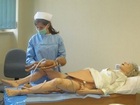












































 Bleeding and screaming models help to educate nurses
Bleeding and screaming models help to educate nursesModern phantoms, or models that simulate the behavior of real patients, will help future nurses and midwives from the Medical University of Silesia (SUM) in learning wound care and making injections. Phantoms can scream, bleed and vomit.
According to the
Dean of the Faculty of Health, Professor. Violetta Skrzypulec-Plinta,
phantoms reacting as a living person should help in better training of
students, because learning will take place in conditions close to real.
This type of simulation has been employed before - now it has a much
more modern form.
In addition to models used to learn various types of wound dressing (e.g. bedsores) and making the least painful injections, nursing and midwifery students may also use a woman in labor simulator. Devices are also capable of simulating breathing disorders in patients.
Phantoms are not the only modern teaching aids in the Educational Centre. Students of physiotherapy acquire practical skills in an adaptive activity teaching room equipped with various types of obstacles (stairs, thresholds), where they learn to navigate in a wheelchair and overcome architectural barriers. Knowledge acquired in this way they will later pass on to the disabled.
Educational Centre has been established in the former
canteen building. As the university spokeswoman, Izabela Życzkowska told
PAP, the cost of adaptation and equipment of the facility amounted to
almost PLN 2 million. The building has over 900 sq. m usable space and
contains a lecture hall, three seminar rooms and a room for disabled
people. The Centre can simultaneously hold classes for 250 students.
Silesian Medical University plans further investments to improve education facilities. The most important include the Centre of Education and Medical Simulation, where students will be able to learn on the premises simulating an operating room or ambulance. They will also have modern phantoms at their disposal, and the acquisition of knowledge will be facilitated by e-learning method. The modern facility will be built in the closed clinical hospital laundry in Katowice-Ligota, and will be the first such project in Poland.
The cost of investment financed by the Operational Programme “Infrastructure and Environment” will be close to PLN 34.5 million. It will probably start in May, and on 1 October 2012 first students will be able to use the facility. In September last year the project found its way to the Ministry of Health, which plans to introduce simulation in the future as one of the methods of teaching medical students.
Medical University of Silesia was established in 1948 and exists under its current name since 2007. The university employs over 1.2 thousand academic teachers. Five faculties in Katowice, Zabrze, Sosnowiec and Bytom educate medical doctors, dentists, pharmacists, medical analysts, biotechnologists, as well as specialists in public health, emergency medicine, dietetics, nursing, midwifery, physiotherapy and cosmetology. More than 32 thousand graduates have already received the university diploma.